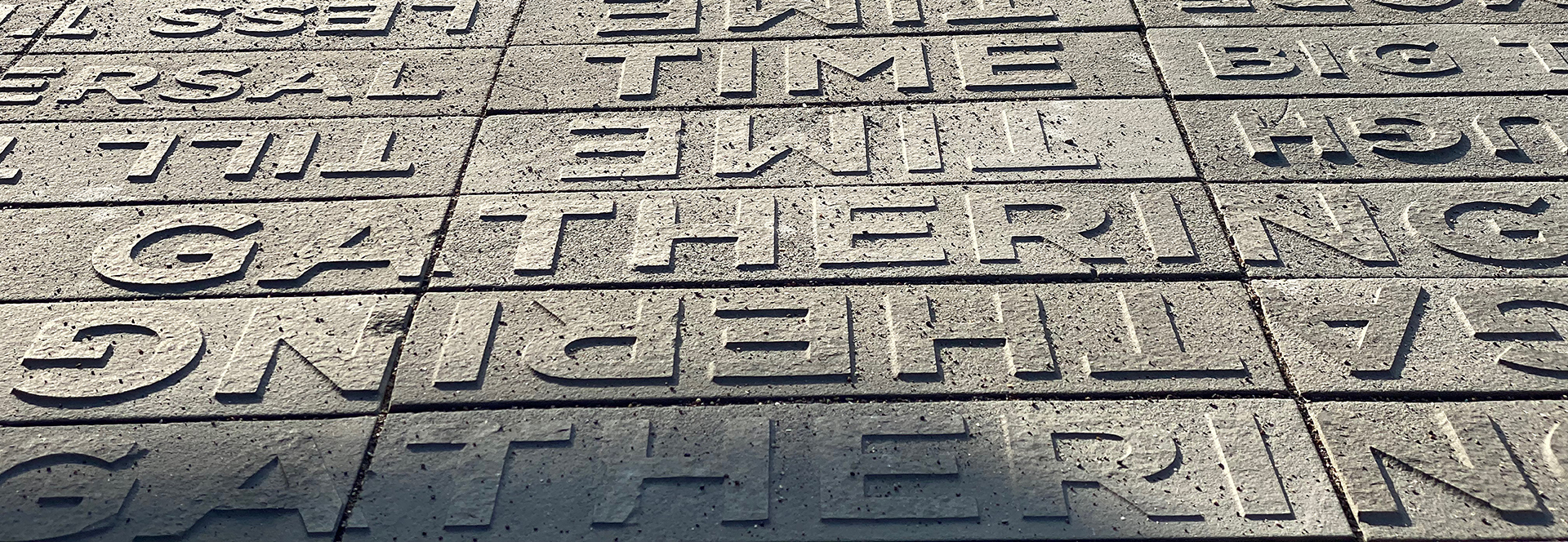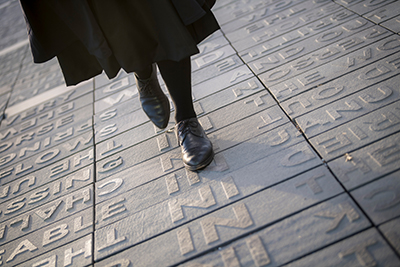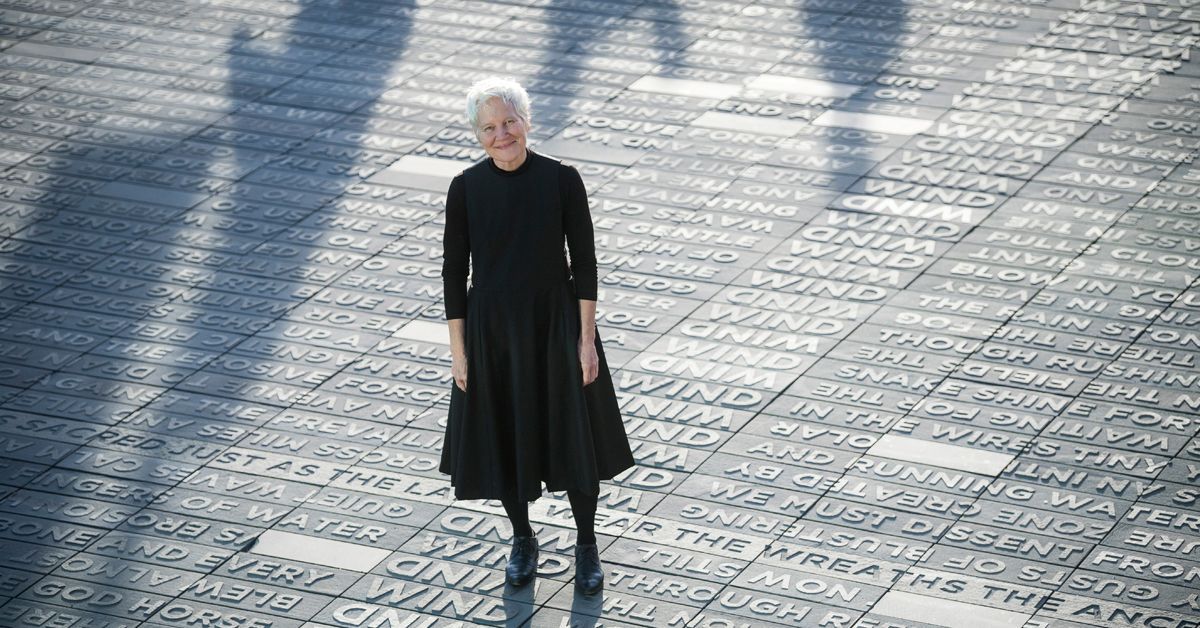Though Set in Stone, Newest Stuart Collection Artwork Tells a Dynamic Story
KAHNOP • TO TELL A STORY debuts as the 22nd addition to UC San Diego’s Stuart Collection
Story by:
Published Date
Article Content
As you exit the UC San Diego Blue Line Trolley at the Central Campus station and make your way down an expansive staircase, your feet will land upon a river of words. The university’s latest public artwork—an 800-foot-long pathway that marks the new entryway to the campus—presents more than 1,300 quote fragments that intricately weave together significant subjects such as feminism, environmental activism, technological advancement and the impact on the Kumeyaay Nation. The work, designed by American visual artist Ann Hamilton and titled KAHNOP • TO TELL A STORY, is the 22nd addition to UC San Diego’s Stuart Collection.
On Saturday, April 29 campus members and the local community are invited to join in a special celebration to mark the completion of the pathway. The free event will be held from 2-4 p.m. and will include activities such as stone rubbings so that visitors can take home a word or phrase that resonates with them and a series of educational posters throughout the walkway that dives deeper into the meaning behind the sculpture.
The event will also include a panel exploring the significance of the land and the original people of the area where the university is located. Assistant Professor of Education Studies Theresa Ambo will lead the discussion with scholars who are engaging local communities in exploring the importance of the region among Kumeyaay people and sharing their work to ensure Indigenous knowledge remains at the forefront rather than relegated to history.
“The mesmerizing poetry Ann Hamilton has weaved throughout this monumental walkway into the campus, is a celebration of the UC San Diego community,” said Jessica Berlanga Taylor, director of the Stuart Collection. “Join us to commemorate the opening of the Stuart Collection's newest addition!”

Word play
KAHNOP • TO TELL A STORY is already becoming a busy pedestrian highway, given its location bisecting UC San Diego’s new Epstein Family Amphitheater and the construction of the forthcoming Pepper Canyon West student housing complex. The buzzing new neighborhood serves as a destination for the campus and local community, the perfect location for Hamilton to explore the relationship between the movement of people, the passage of time and the quality of language.
As you walk along the path, you’ll notice fragments of quotations derived from the works of UC San Diego scholars. Some are raised like a rubber stamp, while others are engraved into the basalt stones. Flowing down the center are a series of words repeated, a common denominator that links the lines together. Though not a traditional concordance—a tool dating back to the 16th century to index words within a text—the artwork does serve as a guide to discover the writings of some of UC San Diego’s most influential people.
Throughout her career, Hamilton has been fascinated by verbal and written language. Trained in textile design and sculpture, the two skill sets often merge in her works. A MacArthur Fellowship recipient and American representative at the Venice Biennale, Hamilton’s installations often combine several mediums to engage multiple senses.
For example, in KAHNOP • TO TELL A STORY, there's a noticeable element of quilting and weaving present. Hamilton describes the work as understated, yet visitors will likely never experience the same stroll twice. “It’s very quiet, subtle; it can disappear,” said Hamilton. “Yet it’s massive. Even if you walk on the pathway every day your gaze will catch different fragments depending on where your eye falls or the state of your own attention. Though set in stone, the piece will remain alive.”
For passersby who are moved by a particular passage, they can uncover the source through a website created in partnership with the UC San Diego Library. Hamilton worked with the Special Collections & Archives team to explore the perspectives of current and former faculty, university founders, prominent alumni and other innovative thinkers who have ties to UC San Diego.
Hamilton and her team listened to the quotes, read them out loud, rearranged their order, even thought about what words would be hidden if someone’s foot fell on an adjacent word while walking. In all, 1,300 quotes from an estimated 300 literature sources were selected for inclusion—each of them available for exploration at kahnop.ucsd.edu, searchable by keyword or by reviewing the entire spine index.
Though most of the work does not read in a linear fashion, astute walkers may notice a narrative interwoven. Walking from east to west, pedestrians are able to follow the narrative of a poem, a new line appearing every 20 feet, made distinct by stones whose words are engraved as opposed to others that are raised. The important addition was inspired by a meeting between Hamilton and two of UC San Diego’s Kumeyaay Scholars, staff member and alumna Eva Trujillo (Mesa Grande Band of Mission Indians) and Alexandria Hunter (enrolled member from Jamul Indian Village), who recently completed her doctoral degree at UC San Diego.

After learning more about the history of Kumeyaay people and culture in San Diego County, Hamilton invited Trujillo and Hunter to write a feminist poem to infuse throughout the pathway, composed in both Kumeyaay and English language. The resulting work is titled Yeechesh Cha’alk (A Woman’s Heart). “It was a natural choice to share the life of Sinyahow, the first woman, and the essence of what she brings to Kumeyaay women,” explained the authors. “Her story is our story, and the events of her life have shaped ceremonies, oral traditions and cultural lifeways of the Kumeyaay people.”
A collection like no other
The first spark that would lead to the creation of KAHNOP • TO TELL A STORY happened more than five years ago when Hamilton met with former Stuart Collection Director Mary Beebe and past Project Manager Mathieu Gregoire. Over the years the work evolved, which included discussions with university planners to devise a way to integrate the pathway into campus construction. These intentional efforts to collaborate with artists to make their vision come to life—and infusing sculptures into the very structures and landscape of the university—is a hallmark of UC San Diego’s Stuart Collection.
“As an artist it is a unique experience to be invited to UC San Diego to respond and be supported in the development and fabrication of a work of this scale,” said Hamilton on her collaboration. “The Stuart Collection has been such a model for other universities; it’s amazing how many people have stepped up and believed in this project. I feel incredibly lucky.”
Over the past 40 years, the Stuart Collection has grown to encompass nearly two dozen artworks from noted contemporary artists such as Mark Bradford (What Hath God Wrought?), Bruce Nauman (Vices and Virtues), Niki de Saint Phalle (Sun God) and Do Ho Suh (Fallen Star). Visitors are invited to take a self-guided walking tour to discover a 180-ton teddy bear, a giant red shoe frolicking in the forest, a winding path in the shape of a snake and other works spanning the 1,200-acre campus.
All sculptures come to life thanks to private donations. The collection began with the support of the Stuart Foundation and has been sustained thanks to the enthusiastic partnership of the UC San Diego Department of Visual Arts, along with financial support from the Friends of the Stuart Collection, the National Endowment for the Arts, and many other organizations, foundations and individuals. Those who are interested in supporting can make a contribution to the Mary Beebe Legacy Endowment fund.
You May Also Like
Stay in the Know
Keep up with all the latest from UC San Diego. Subscribe to the newsletter today.




